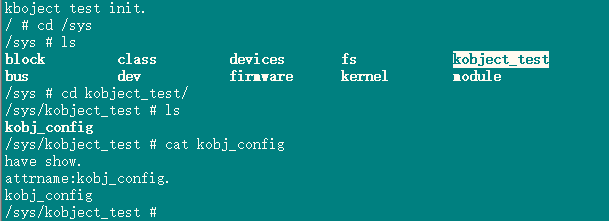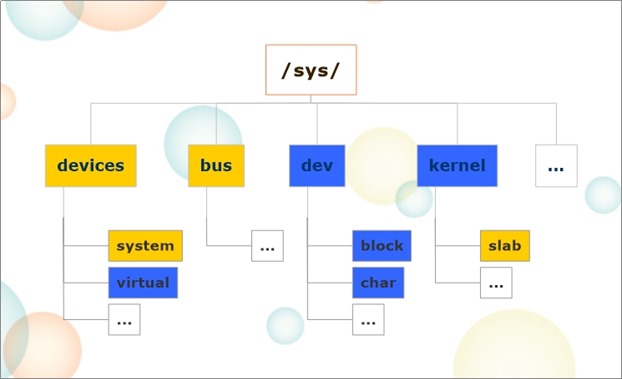LDD3中说,Kobject的作用为:
1、sysfs 表述:在 sysfs 中出现的每个对象都对应一个 kobject, 它和内核交互来创建它的可见表述。
2、热插拔事件处理 :kobject 子系统将产生的热插拔事件通知用户空间。
3、数据结构关联:整体来看, 设备模型是一个极端复杂的数据结构,通过其间的大量链接而构成一个多层次的体系结构。kobject 实现了该结构并将其聚合在一起。
此篇文章,只分析第一条,kobject 与 kset sysfs 之间的关系。剩下的两条将在后续的两篇文章中分析
首先,什么是 kobject ,它也不过是内核里的一个结构体而已
struct kobject {
const char *name;
struct list_head entry;
struct kobject *parent;
struct kset *kset;
struct kobj_type *ktype;
......// 省略一些暂时不想看到的东西
};
那么,这个结构体有何特殊之处呢?
每一个 kobject 对应 文件系统 /sys 里的一个 目录,目录的名字就是结构体中的 name
什么又是 kset ,kset 也是个结构体而已
struct kset {
struct list_head list;
struct kobject kobj;
struct kset_uevent_ops *uevent_ops;
spinlock_t list_lock;
};
我们前面说了,每一个 kobj 对应 文件系统 /sys 里的一个 目录,那么每一个 kset 都包含了一个 kobj,那样的话,kset也对应于 /sys 里的一个 目录
简单来说,kset 与 kobj 都是目录,既然是目录,那么在就是一个树状结构,每一个目录都将有一个 父节点,
在kset中使用kset.kobj->parent 指定
在kboject中使用 kobj->parent 指定
显然,整个树状目录结构,都是通过kobj来构建的,只不过有些kobj嵌在Kset里,分析目录结构时把kset当成一个普通的kobj会好理解很多。
那么kset 有何特殊之处呢?
我们可以看到 kset 结构中有一个链表,它目录下的 一些相同类型的kobj会在创建时链入链表,也就是说Kset是一些kobj的集合。
干说还是比较抽象的,那么我们就来看看 /sys 目录底下的这些东西,哪些是kset 哪些是kobj 结构又是怎样的。
看过代码的应该知道,想要在/sys 目录下创建 目录,那就要 构造 kset 或者 kobj 设置并注册。
对于kobject:
kobject_create_and_add
kobject_init_and_add
对于kset:
kset_create_and_add
我在这3个函数中增加了prink打印语句,打印内核创建的每一个 kobj 或者 kset 的名字,以及父节点的名字,甚至它指向的kset的kobj的名字。
原本我以为,较高层次的目录会是kset,因为它是个集合嘛,然而并不全是。
the kset name is devices,no parent
the kset name is system,parent's name is devices
the kobject name is virtual,parent's name is devices
the kset name is bus,no parent
the kset name is class,no parent
the kset name is module,no parent
the kobject name is fs,no parent
the kobject name is dev,no parent
the kobject name is block,parent's name is dev
the kobject name is char,parent's name is dev
the kobject name is firmware,no parent
the kobject name is kernel,no parent
the kset name is slab,parent's name is kernel
the kobject name is block,no parent
写着no parent的,在/sys/目录下可以找到它们,对于devices、bus、class、module它们是kset
对于fs、dev、firmware、kernel、block 它们是 kobj
而且,我们还可以发现
1、 kset 底下可以放 kset (但是无法链入链表,分析代码时会知道)
the kset name is devices,no parent
the kset name is system,parent's name is devices
2、 kset 底下可以放 kobj (可以链入链表,也可以不链入)
the kset name is devices,no parent
the kobject name is virtual,parent's name is devices
3、 kobject 底下可以放 kset (显然没链表的概念了)
the kobject name is kernel,no parent
the kset name is slab,parent's name is kernel
4、 kobj 底下放 kobj (同样没有链表的概念)
the kobject name is dev,no parent
the kobject name is block,parent's name is dev
那么,至此我们对kset kobj它们之间的联系就应该有一个比较浅显的认识了。
------------------------------------------------------------------------------------------------------------------------------------------------------
下面来分析代码,进一步摸索,先把图贴上来,虚线表示可能的其它一些连接情况。
---------------------------------------------------------------------------------------------------------------------------------------------------------------
struct kobject *kobject_create_and_add(const char *name, struct kobject *parent)
{
struct kobject *kobj;
kobj = kobject_create();
retval = kobject_add(kobj, parent, "%s", name);
return kobj;
}
kobject_create_and_add
kobject_create // kobj = kzalloc(sizeof(*kobj), GFP_KERNEL);
kobject_init // kobj->ktype = ktype;
kobject_init_internal // kref_init(&kobj->kref);
kobject_add
kobject_add_varg // retval = kobject_set_name_vargs(kobj, fmt, vargs); // kobj->parent = parent;
kobject_add_internal
if (kobj->kset) { // kobj->kset == NULL 不执行
if (!parent)
parent = kobject_get(&kobj->kset->kobj);
kobj_kset_join(kobj);
kobj->parent = parent;
}
create_dir
kobject_create_and_add 函数从 构建一个kobject到 在sysfs中创建路径一气呵成,其中没有关于kset的设置,仅仅是设置了parent ktype
如果 kobject_create_and_add 传入的 parent 参数 是一个普通的kobject ,那么就与应于图中的③与⑤的关系
如果 kobject_create_and_add 传入的 parent 参数 是一个kset->kobject,那么就与应于图中的③与④的关系
---------------------------------------------------------------------------------------------------------------------------------------------------------------
priv->kobj.kset = bus->p->drivers_kset; // 设置它所属的Kset
error = kobject_init_and_add(&priv->kobj, &driver_ktype, NULL, "%s", drv->name);
int kobject_init_and_add(struct kobject *kobj, struct kobj_type *ktype,
struct kobject *parent, const char *fmt, ...)
{
kobject_init(kobj, ktype);
retval = kobject_add_varg(kobj, parent, fmt, args);
}
kobject_init_and_add
kobject_init // kobj->ktype = ktype;
kobject_init_internal // kref_init(&kobj->kref);
kobject_add_varg // retval = kobject_set_name_vargs(kobj, fmt, vargs); // kobj->parent = parent;
kobject_add_internal
if (kobj->kset) { // 将kobject 添加到它所指向的kset->list中
if (!parent)
parent = kobject_get(&kobj->kset->kobj);
kobj_kset_join(kobj);
kobj->parent = parent; // 如果没有parent 将它所属的kset->kobj作为它的parent
}
create_dir
与kobject_create_and_add 相比 就是少了构建kobkject,然而这样给了我们设置kset的机会,同时往往不会设置parent
对应于图中的①与④的关系
---------------------------------------------------------------------------------------------------------------------------------------------------------------
struct kset *kset_create_and_add(const char *name,
struct kset_uevent_ops *uevent_ops,
struct kobject *parent_kobj)
kset = kset_create(name, uevent_ops, parent_kobj);
error = kset_register(kset);
}
kset_create_and_add
kset_create
kset = kzalloc(sizeof(*kset), GFP_KERNEL);
retval = kobject_set_name(&kset->kobj, name);
kset->uevent_ops = uevent_ops;
kset->kobj.parent = parent_kobj;
kset->kobj.ktype = &kset_ktype;
kset->kobj.kset = NULL;
kset_register
kset_init(k);
err = kobject_add_internal(&k->kobj);
parent = kobject_get(kobj->parent);
if (kobj->kset) { // kobj->kset==NULL 不执行
....
}
error = create_dir(kobj);
kset_create_and_add 无法将 创建kset->kobj.kset 指向任何kset
但是kset->kobj.parent 还是能和kobj.parent指向 普通的kobj 或者包含在kset里的kobj
如果 kset_create_and_add 传入的 parent 参数 是一个普通的kobject ,那么就与应于图中的④与⑤的关系
如果 kset_create_and_add 传入的 parent 参数 是一个kset->kobject,那么就与应于图中的②与④的关系
-------------------------------------------------------------------------------------------------------------------------------------------------------------
还有一种情况就是,创建一个 kset 并设置kset.kobject.kset
然后调用 kset_register
kset_register
kset_init(k);
err = kobject_add_internal(&k->kobj);
parent = kobject_get(kobj->parent);
if (kobj->kset) { // 将kobject 添加到它所指向的kset->list中
if (!parent)
parent = kobject_get(&kobj->kset->kobj);
kobj_kset_join(kobj);
kobj->parent = parent; // 如果没有parent 将它所属的kset->kobj作为它的parent
}
error = create_dir(kobj);
对应于图中④与⑥的关系。
-------------------------------------------------------------------------------------------------------------------------------------------------------------
上面代码的细节,比如如何在/sys/创建路径请参考:http://blog.csdn.net/lizuobin2/article/details/51511336
到此,我们应该对 kobject kset sysfs 之间的目录关系比较清楚了,但是我们至少还应该看看ktype,至于Kset中的热插拔在第二条中分析好了。
struct kobject {
const char *name;
struct list_head entry;
struct kobject *parent;
struct kset *kset;
struct kobj_type *ktype;
struct kref kref;
……
};
struct kobj_type {
void (*release)(struct kobject *kobj);
struct sysfs_ops *sysfs_ops;
struct attribute **default_attrs; //struct attribute *default_attrs[]
};
ktype 由一个release函数、一个sysfs_ops、一个指针数组(二维指针)组成
1、release 函数
每一个Kobject 都必须有一个release方法,有意思的是,release 函数并没有包括在kobject自身内,而是包含在它的结构体成员Ktype内。而且kobject在调用release之前应该保持稳定(不明白抄自LDD3)。
2、struct attribute **default_attrs
struct attribute {
const char *name;
struct module *owner;
mode_t mode;
};
default_attrs 指向的地方 是个指针数组,这些指针的类型为attribute ,那么这些attribute 就是该kobject的属性了,name 是属性的名字,在kobject目录下 表现为 文件 ,owner 指向模块的指针(如果有的话),那么该模块负责实现这些属性。mode 是保护位,通常是S_IRUGO,可写的则用S_IWUSR 仅为root提供写权限。default_attrs最后一个元素必须为0,要不然它找不着北~
3、sysfs_opes 实现属性的方法
struct sysfs{
ssize_t *show(struct kobject *kobject, struct attribute *attr,char *buf);
ssize_t *store(struct kobject *kobject, struct attribute *attr,char *buf, size_t size);
}
在内核里,一类设备往往使用相同的show , store函数。
附上一个例子:linux2.6.32.2 编译通过
- </pre><p><pre name="code" class="cpp">#include <linux/device.h>
- #include <linux/module.h>
- #include <linux/kernel.h>
- #include <linux/init.h>
- #include <linux/string.h>
- #include <linux/sysfs.h>
- #include <linux/stat.h>
- MODULE_AUTHOR("David Xie");
- MODULE_LICENSE("Dual BSD/GPL");
- ---------------------------------------default_attrs------------------------------------------------
- /*对应于kobject的目录下的一个文件,Name成员就是文件名*/
- struct attribute test_attr = {
- .name = "kobj_config",
- .mode = S_IRWXUGO,
- };
- static struct attribute *def_attrs[] = {
- &test_attr,
- NULL,
- };
- ---------------------------------------sysfs_ops----------------------------------------------------
- /*当读文件时执行的操作*/
- ssize_t kobj_test_show(struct kobject *kobject, struct attribute *attr,char *buf)
- {
- printk("have show.\n");
- printk("attrname:%s.\n", attr->name);
- sprintf(buf,"%s\n",attr->name);
- return strlen(attr->name)+2;
- }
- /*当写文件时执行的操作*/
- ssize_t kobj_test_store(struct kobject *kobject,struct attribute *attr,const char *buf, size_t count)
- {
- printk("havestore\n");
- printk("write: %s\n",buf);
- return count;
- }
- //kobject对象的操作
- struct sysfs_ops obj_test_sysops =
- {
- .show = kobj_test_show,
- .store = kobj_test_store,
- };
- ---------------------------------------release-------------------------------------------------------
- /*release方法释放该kobject对象*/
- void obj_test_release(struct kobject *kobject)
- {
- printk("eric_test: release .\n");
- }
- ---------------------------------------kobj_type-----------------------------------------------------
- /*定义kobject对象的一些属性及对应的操作*/
- struct kobj_type ktype =
- {
- .release = obj_test_release,
- .sysfs_ops=&obj_test_sysops,
- .default_attrs=def_attrs,
- };
- struct kobject kobj;//声明kobject对象
- static int kobj_test_init(void)
- {
- printk("kboject test init.\n");
- kobject_init_and_add(&kobj,&ktype,NULL,"kobject_test");//初始化kobject对象kobj,并将其注册到linux系统
- //kobject_init(&kobj);
- //kobj.ktype = &ktype;
- //kobj.parent = NULL;
- //kobject_set_name(&kobj, "kobject_test");
- //err = kobject_add(&kobj);
- return 0;
- }
- static void kobj_test_exit(void)
- {
- printk("kobject test exit.\n");
- kobject_del(&kobj);
- }
- module_init(kobj_test_init);
- module_exit(kobj_test_exit);
</pre><p><pre name="code" class="cpp">#include <linux/device.h>
#include <linux/module.h>
#include <linux/kernel.h>
#include <linux/init.h>
#include <linux/string.h>
#include <linux/sysfs.h>
#include <linux/stat.h> MODULE_AUTHOR("David Xie");
MODULE_LICENSE("Dual BSD/GPL"); ---------------------------------------default_attrs------------------------------------------------
/*对应于kobject的目录下的一个文件,Name成员就是文件名*/
struct attribute test_attr = { .name = "kobj_config", .mode = S_IRWXUGO,
};static struct attribute *def_attrs[] = { &test_attr, NULL,
};
---------------------------------------sysfs_ops----------------------------------------------------
/*当读文件时执行的操作*/
ssize_t kobj_test_show(struct kobject *kobject, struct attribute *attr,char *buf)
{ printk("have show.\n"); printk("attrname:%s.\n", attr->name); sprintf(buf,"%s\n",attr->name); return strlen(attr->name)+2;
} /*当写文件时执行的操作*/
ssize_t kobj_test_store(struct kobject *kobject,struct attribute *attr,const char *buf, size_t count)
{ printk("havestore\n"); printk("write: %s\n",buf); return count;
}
//kobject对象的操作
struct sysfs_ops obj_test_sysops =
{ .show = kobj_test_show, .store = kobj_test_store,
};
---------------------------------------release-------------------------------------------------------
/*release方法释放该kobject对象*/
void obj_test_release(struct kobject *kobject)
{ printk("eric_test: release .\n");
}
---------------------------------------kobj_type----------------------------------------------------- /*定义kobject对象的一些属性及对应的操作*/
struct kobj_type ktype =
{ .release = obj_test_release, .sysfs_ops=&obj_test_sysops, .default_attrs=def_attrs,
}; struct kobject kobj;//声明kobject对象 static int kobj_test_init(void)
{ printk("kboject test init.\n"); kobject_init_and_add(&kobj,&ktype,NULL,"kobject_test");//初始化kobject对象kobj,并将其注册到linux系统 //kobject_init(&kobj); //kobj.ktype = &ktype; //kobj.parent = NULL; //kobject_set_name(&kobj, "kobject_test"); //err = kobject_add(&kobj); return 0;
} static void kobj_test_exit(void)
{ printk("kobject test exit.\n"); kobject_del(&kobj);
} module_init(kobj_test_init);
module_exit(kobj_test_exit); 
核心结论:
1、sys 目录下的层次结构依赖于 kobject.parent ,未指定parent时,默认使用 kobject.kset.kobject 作为 parent,如果都没有,就出现在 /sys 目录下。
2、该 kobject 目录下的属性文件依赖于 kobject.ktype








对数据库结构的增删改查)












